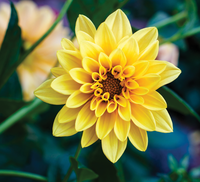Sharp Contrast
In macro photography, multiple images are merged together in order to generate a single picture. Under Linux, the enfuse tool performs this task. An alternative approach is to use GIMP, which lets you merge images manually, an approach that brings with it additional possibilities.
Macro photography is fascinating for many. This form of photography often presents details that would otherwise be overlooked, because it is able to put them into proper focus. However, it is impossible to make a sharp macro photo of an entire object because not all of its depth of field can be in focus at once. This is mostly due to restrictions imposed by the optical properties inherent in the combination of camera and lens. The larger the sensor and the focal distance, the smaller the depth of field will appear. Beyond a certain point, an open aperture will only capture a sharp region that is just a few millimeters in size. As an aside, these optical properties also explain why small compact cameras with small sensors and lenses frequently do a surprisingly good job of making photographs with a large depth of field. Even so, the quality of the sensors and lenses in these cameras is normally not as good as it is in larger cameras.
Strong stopping down improves depth of field (see the "Stopping Down" box). However, this approach only works for smaller regions of an image. Contemporary lenses have a maximum aperture size of 22. The f-number is equal to the ratio of the focal length to the entrance pupil. It used to be that lenses had larger f-numbers. This quickly led to flexion and in turn, to blurring. As a result, stopping down may not be a good solution. Problems that occur with this approach include:
- The sharpness is limited to a relatively narrow region even with a large stop down.
- The prolonged exposure times mean that even slow moving objects are often impossible to photograph.
- Sharpness is not optimal with a small aperture opening, and it is often not possible to manually adjust for optimization.
[...]
Use Express-Checkout link below to read the full article (PDF).
